Shelter sequence pictures
Click on pics for larger view in new window.
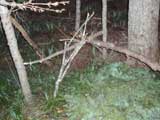 |
The spot was selected, and a "bough bed*" is laid in place. A ridge pole is supported at the head of the shelter using "Y" shaped sticks. A small pole jammed between to smaller trees further stabilizes the structure.
* Construct a bough bed at least 18" deep (thick), anything less is too easily compressed, and looses its insulating value.
|
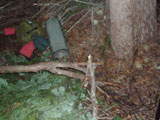 |
Two "Y" shaped sticks also support the foot end of the ridge pole - forked branches in the ridge pole are used to orient the natural curve up.
|
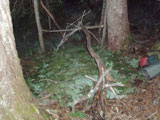 |
Ridge pole in place, time to add more of the framework...
(Note the shelter is being built in a grove of larger trees for the shelter they provide. A clearing to the east allows for early morning sun exposure.)
|
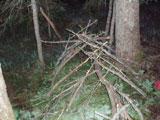 |
... which is done with the boughs that have been stripped of their needles and smaller branches for use in building the bough bed.
|
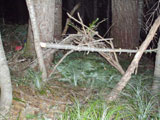 |
The view from the other end of the structure shows how the natural curve of the stripped bough branches is used to curve the walls out.
|
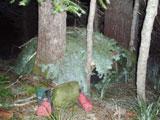 |
Starting at the bottom, fir and cedar boughs are crisscrossed over the framework, layer-after-layer. Ensure the boughs (and needles) are oriented down to shed water.
If, during daylight hours, you can see light through the shelter while lying inside; you need more layers - pile it on!
|
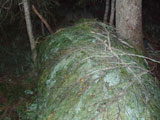 |
Building a thick layer is key to creating the "dead air space" that will insulate the occupant. Proper thickness will also provide shelter from rain and snow.
|
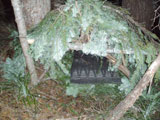 |
This view shows the shelter was built just big enough for someone to wiggle into; a spacious shelter only means more area for your precious body heat to warm up. A close cell foam pad adds comfort, and more insulation from the ground. Think in terms of building a "sleeping bag" instead of a "hut."
|
The clear, cold night, with temperatures hovering around the freezing level, was comfortably spent without a fire (or sleeping bag). This type of shelter, properly constructed, will provide protection from much more extreme conditions.
Use the wealth of resources available, and develop your shelter building skills.
Vary your sources, practice your methods. Another...







